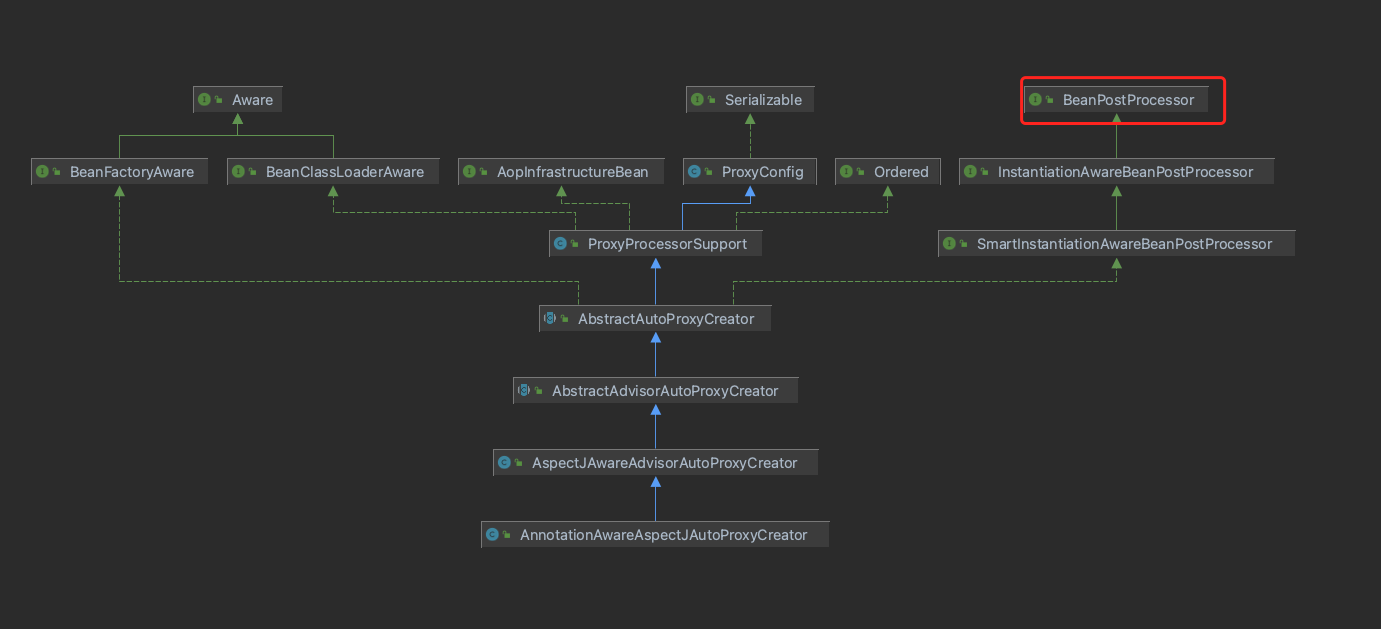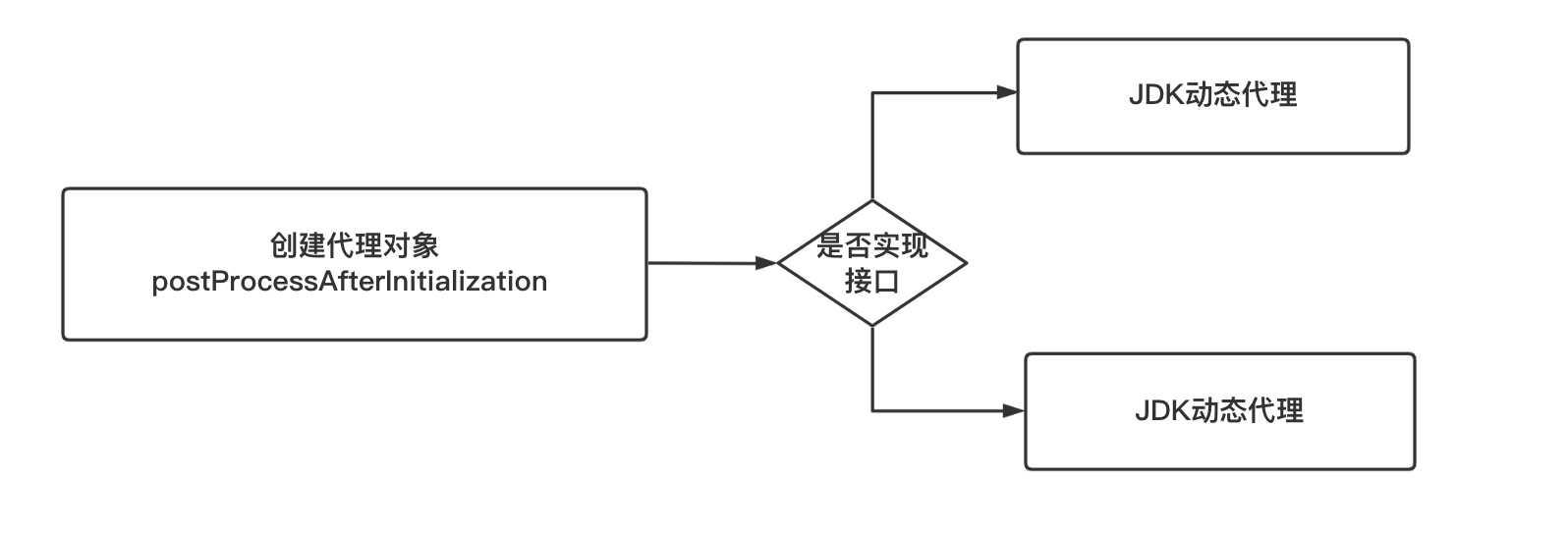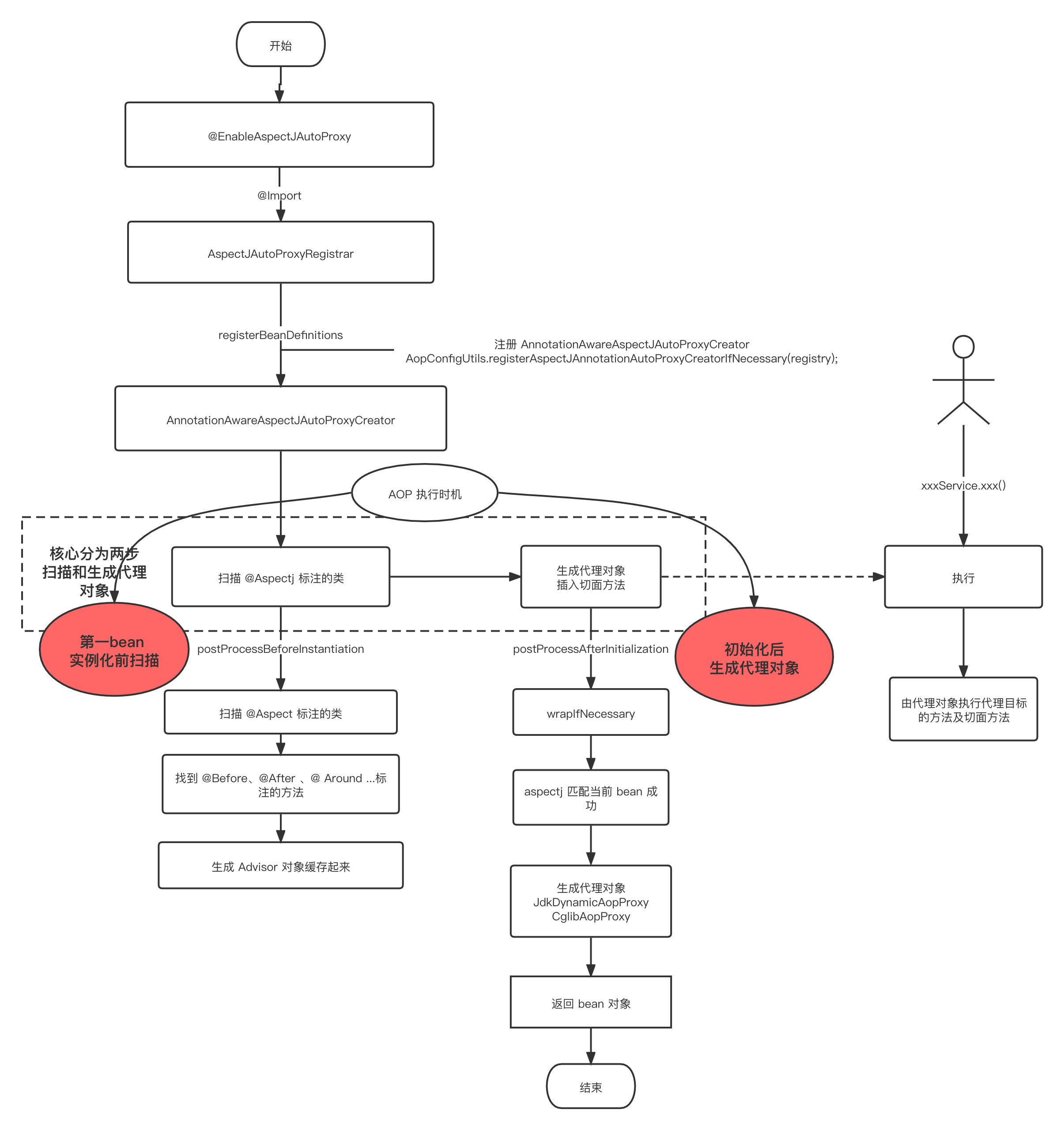先学会如何使用
Spring-boot 或 Spring-cloud 中使用AOP
在Spring-boot 工程中使用AOP功能,先引入相关的依赖。
pom.xml
1
2
3
4
5
6
7
8
9
10
11
12
13
14
15
16
17
18
19
20
21
22
23
24
25
26
27
|
<dependency>
<groupId>org.springframework.boot</groupId>
<artifactId>spring-boot-starter-web</artifactId>
</dependency>
<dependency>
<groupId>org.springframework.boot</groupId>
<artifactId>spring-boot-starter-aop</artifactId>
</dependency>
<dependency>
<groupId>org.projectlombok</groupId>
<artifactId>lombok</artifactId>
<version>1.18.22</version>
</dependency>
<dependency>
<groupId>org.springframework.boot</groupId>
<artifactId>spring-boot-starter-test</artifactId>
<scope>test</scope>
<exclusions>
<exclusion>
<groupId>org.junit.vintage</groupId>
<artifactId>junit-vintage-engine</artifactId>
</exclusion>
</exclusions>
</dependency>
|
测试业务接口 UserService.java
1
2
3
|
public interface UserService {
void test();
}
|
测试业务接口实现类 UserServiceImp.java
1
2
3
4
5
6
7
8
|
@Slf4j
@Service
public class UserServiceImpl implements UserService {
@Override
public void test() {
log.info("执行业务方法test...");
}
}
|
切面类 LogAspect.java
1
2
3
4
5
6
7
8
9
10
11
12
13
14
15
16
17
18
19
20
|
@Slf4j
@Aspect
@Component
public class LogAspect {
@Pointcut("execution(public * com.example.service.impl.*.*(..))")
public void pointcut() {
}
@Before("pointcut()")
public void before() {
log.info("Before通知 -> 业务方法执行前调用...");
}
@After("pointcut()")
public void after() {
log.info("After通知 -> 业务方法执行后调用...");
}
}
|
启动类 Application.java
1
2
3
4
5
6
7
8
|
@SpringBootApplication
public class Application {
public static void main(String[] args) {
SpringApplication.run(Application.class, args);
}
}
|
执行测试类 UserServiceTest.java
1
2
3
4
5
6
7
8
9
10
11
12
13
14
15
16
|
@SpringBootTest
public class SpringTests {
}
class UserServiceTest extends SpringTests {
@Autowired
private UserService userService;
@Test
void test() {
userService.test();
}
}
|
1
2
3
|
INFO 53837 --- [ main] com.example.aspect.LogAspect : Before通知 -> 业务方法执行前调用...
INFO 53837 --- [ main] c.example.service.impl.UserServiceImpl : 执行业务方法test...
INFO 53837 --- [ main] com.example.aspect.LogAspect : After通知 -> 业务方法执行后调用...
|
可以看到,在springboot项目中只要引入 spring-boot-starter-aop 包,默认会自动开启AOP功能。
这是因为SpringBoot自动配置的特性,如下是AOP的配置类,默认是开启。
1
2
3
4
5
6
7
8
9
10
11
12
13
14
15
16
17
18
19
20
21
22
23
24
25
26
|
@Configuration(proxyBeanMethods = false)
@ConditionalOnProperty(prefix = "spring.aop", name = "auto", havingValue = "true", matchIfMissing = true)
public class AopAutoConfiguration {
//
@Configuration(proxyBeanMethods = false)
@ConditionalOnClass(Advice.class)
static class AspectJAutoProxyingConfiguration {
@Configuration(proxyBeanMethods = false)
@EnableAspectJAutoProxy(proxyTargetClass = false)
@ConditionalOnProperty(prefix = "spring.aop", name = "proxy-target-class", havingValue = "false",
matchIfMissing = false)
static class JdkDynamicAutoProxyConfiguration {
}
@Configuration(proxyBeanMethods = false)
@EnableAspectJAutoProxy(proxyTargetClass = true)
@ConditionalOnProperty(prefix = "spring.aop", name = "proxy-target-class", havingValue = "true",
matchIfMissing = true)
static class CglibAutoProxyConfiguration {
}
}
}
|
-
根据ConditionalOnProperty条件注解,当前环境中存在 spring.aop.auto,且值为true会启用该配置类, 而matchIfMissing的值为 true, 表明当没有手动配置 spring.aop.auto 时其默认值为true, 即默认开启AOP自动配置。
-
havingValue 表示手动配置的值和havingValue的值相等时才生效。
-
通过 AspectJAutoProxyingConfiguration 内部类注入 JdkDynamicAutoProxyConfiguration 和 CglibAutoProxyConfiguration 配置类型,到底哪一个会生效呢 ?
-
CglibAutoProxyConfiguration会生效,因为没有配置spring.aop.proxy-target-class时CglibAutoProxyConfiguration上的默认值为true, 所以CglibAutoProxyConfiguration配置生效。
-
matchIfMissing 表示没有手动配置时 spring.aop.proxy-target-class 配置的默认值。
-
通过 @EnableAspectJAutoProxy(proxyTargetClass = true) 开启AOP功能,这是实现AOP的关键。
原理分析
Spring-AOP 的原理可以划分为三个步骤,总共做了三件事,分别是解析切面、创建动态代理、调用代理方法。

解析切面:
在Spring容器启动的过程中会扫描所有的切面类,即标注@Aspect的bean,解析该类中的所有通知方法,生成Advisor,每个含有 @Before、@After… 的类都是一个通知,都会生成一个Advisor,最后将所有解析好的Advisor保存在缓存中。
创建代理对象:
根据切点表达式匹配所有bean和方法,如果匹配成功,实现了接口的bean使用JDK动态代理,没有实现接口使用Cglib动态代理。
调用代理方法:
当调用被代理的类的方法是,AOP会在执行目标方法前后执行被植入的切面逻辑。
解析切面
从入口 @EnableAspectJAutoProxy 开始。
导入了另一个类 AspectJAutoProxyRegistrar,@Import注解可以将一个普通类注入到spring容器,注册成bean。
1
2
|
@Import(AspectJAutoProxyRegistrar.class)
public @interface EnableAspectJAutoProxy {}
|
1
2
3
4
5
6
7
8
9
10
11
12
13
14
15
16
17
18
19
20
21
22
23
24
|
class AspectJAutoProxyRegistrar implements ImportBeanDefinitionRegistrar {
@Override
public void registerBeanDefinitions(
AnnotationMetadata importingClassMetadata, BeanDefinitionRegistry registry) {
// 注入AOP核心类型
AopConfigUtils.registerAspectJAnnotationAutoProxyCreatorIfNecessary(registry);
// 获取 EnableAspectJAutoProxy 注解中的 proxyTargetClass 和 exposeProxy 执行。
// proxyTargetClass = true 表示都使用cglib代理。
// exposeProxy = true 暴露代理对象到AOP的上下文,可以通过AopContext获取。
AnnotationAttributes enableAspectJAutoProxy =
AnnotationConfigUtils.attributesFor(importingClassMetadata, EnableAspectJAutoProxy.class);
if (enableAspectJAutoProxy != null) {
if (enableAspectJAutoProxy.getBoolean("proxyTargetClass")) {
AopConfigUtils.forceAutoProxyCreatorToUseClassProxying(registry);
}
if (enableAspectJAutoProxy.getBoolean("exposeProxy")) {
AopConfigUtils.forceAutoProxyCreatorToExposeProxy(registry);
}
}
}
}
|
这里导入的是 ImportBeanDefinitionRegistrar 类型的bean, 通过实现 registerBeanDefinitions 方法可以注入其他任何类型的bean。
关于ImportBeanDefinitionRegistrar 的用法参考另一篇文章:https://juejin.cn/post/7039308644768284679
关键是注册了另一个bean,AnnotationAwareAspectJAutoProxyCreator 。

AnnotationAwareAspectJAutoProxyCreator 实现了 BeenPostProcessor接口 , 是bean的后置处理器。
BeenPostProcessor 中有两个重要方法如下,他们分别在bean初始化前后执行。
1
2
3
4
5
6
7
|
default Object postProcessBeforeInitialization(Object bean, String beanName) throws BeansException {
return bean;
}
default Object postProcessAfterInitialization(Object bean, String beanName) throws BeansException {
return bean;
}
|
- postProcessBeforeInitialization 在bean 初始化前执行。
- postProcessAfterInitialization 在 bean 初始化后执行。
另外还实现了 InstantiationAwareBeanPostProcessor接口,该类也有两个方法,分别在bean实例化前后执行。
1
2
3
4
5
6
|
default Object postProcessBeforeInstantiation(Class<?> beanClass, String beanName) throws BeansException {
return null;
}
default boolean postProcessAfterInstantiation(Object bean, String beanName) throws BeansException {
return true;
}
|
- postProcessBeforeInstantiation 在bean实例化前执行。
- postProcessAfterInstantiation 在bean实例化后执行。
以上四个方法是AOP解析切面、创建代理的关键,在抽象类AbstractAutoProxyCreator中分别实现了这四个方法。
1
2
3
4
5
6
7
8
9
10
11
12
13
14
15
16
17
18
19
20
21
22
23
24
25
26
27
28
29
30
31
32
33
34
35
36
37
38
39
40
41
42
43
44
45
46
47
48
49
|
@Override
public Object postProcessBeforeInstantiation(Class<?> beanClass, String beanName) {
Object cacheKey = getCacheKey(beanClass, beanName);
if (!StringUtils.hasLength(beanName) || !this.targetSourcedBeans.contains(beanName)) {
if (this.advisedBeans.containsKey(cacheKey)) {
return null;
}
// 解析切面
if (isInfrastructureClass(beanClass) || shouldSkip(beanClass, beanName)) {
this.advisedBeans.put(cacheKey, Boolean.FALSE);
return null;
}
}
TargetSource targetSource = getCustomTargetSource(beanClass, beanName);
if (targetSource != null) {
if (StringUtils.hasLength(beanName)) {
this.targetSourcedBeans.add(beanName);
}
Object[] specificInterceptors = getAdvicesAndAdvisorsForBean(beanClass, beanName, targetSource);
Object proxy = createProxy(beanClass, beanName, specificInterceptors, targetSource);
this.proxyTypes.put(cacheKey, proxy.getClass());
return proxy;
}
return null;
}
@Override
public boolean postProcessAfterInstantiation(Object bean, String beanName) {
return true;
}
@Override
public Object postProcessBeforeInitialization(Object bean, String beanName) {
return bean;
}
@Override
public Object postProcessAfterInitialization(@Nullable Object bean, String beanName) {
if (bean != null) {
Object cacheKey = getCacheKey(bean.getClass(), beanName);
if (this.earlyProxyReferences.remove(cacheKey) != bean) {
// 创建代理
return wrapIfNecessary(bean, beanName, cacheKey);
}
}
return bean;
}
|
在 postProcessBeforeInstantiation 方法中实现了切面解析的逻辑,会在第一个bean实例化前执行。
在 postProcessAfterInitialization 方法中实现创建代理,在bean初始化后执行。
切面解析入口方法 postProcessBeforeInstantiation
1
2
3
4
5
6
7
8
9
10
11
12
13
14
15
16
17
18
19
20
|
// 切面bean缓存
private final Map<Object, Boolean> advisedBeans = new ConcurrentHashMap<>(256);
@Override
public Object postProcessBeforeInstantiation(Class<?> beanClass, String beanName) {
Object cacheKey = getCacheKey(beanClass, beanName);
if (!StringUtils.hasLength(beanName) || !this.targetSourcedBeans.contains(beanName)) {
// 如果已经解析返回
if (this.advisedBeans.containsKey(cacheKey)) {
return null;
}
// 解析切面
if (isInfrastructureClass(beanClass) || shouldSkip(beanClass, beanName)) {
this.advisedBeans.put(cacheKey, Boolean.FALSE);
return null;
}
}
return null;
}
|
postProcessBeforeInstantiation 在bean实例化前执行。
shouldSkip 方法中实现注解方式AOP的解析过程。
解析过的切面会把beanName存入 advisedBeans 缓存中, 不再重复解析。
解析切面核心方法 shouldSkip
1
2
3
4
5
6
7
8
9
10
11
12
|
@Override
protected boolean shouldSkip(Class<?> beanClass, String beanName) {
// TODO: Consider optimization by caching the list of the aspect names
List<Advisor> candidateAdvisors = findCandidateAdvisors();
for (Advisor advisor : candidateAdvisors) {
if (advisor instanceof AspectJPointcutAdvisor &&
((AspectJPointcutAdvisor) advisor).getAspectName().equals(beanName)) {
return true;
}
}
return super.shouldSkip(beanClass, beanName);
}
|
1
2
3
4
5
6
7
8
9
10
|
@Override
protected List<Advisor> findCandidateAdvisors() {
// Add all the Spring advisors found according to superclass rules.
List<Advisor> advisors = super.findCandidateAdvisors();
// Build Advisors for all AspectJ aspects in the bean factory.
if (this.aspectJAdvisorsBuilder != null) {
advisors.addAll(this.aspectJAdvisorsBuilder.buildAspectJAdvisors());
}
return advisors;
}
|
shouldSkip 中调用 findCandidateAdvisors() 解析所有候选的切面,切面有两种切面,一种是基于接口的切面,一种是基于注解的切面。
解析接口方式的切面
一种是调用 super.findCandidateAdvisors() 解析所有实现Advisor接口的切面bean。
1
2
3
4
5
6
7
8
9
10
11
12
13
14
15
16
17
18
|
protected List<Advisor> findCandidateAdvisors() {
return this.advisorRetrievalHelper.findAdvisorBeans();
}
public List<Advisor> findAdvisorBeans() {
String[] advisorNames = this.cachedAdvisorBeanNames;
if (advisorNames == null) {
// Do not initialize FactoryBeans here: We need to leave all regular beans
// uninitialized to let the auto-proxy creator apply to them!
advisorNames = BeanFactoryUtils.beanNamesForTypeIncludingAncestors(
this.beanFactory, Advisor.class, true, false);
this.cachedAdvisorBeanNames = advisorNames;
}
if (advisorNames.length == 0) {
return new ArrayList<>();
}
// ... 略
}
|
这里的核心操作是解析所有实现 Advisor 接口的bean, 缓存起来。
解析注解方式的切面
另一种调用 aspectJAdvisorsBuilder.buildAspectJAdvisors() 解析所有注解方式的切面。
1
2
3
4
|
// Advisor缓存,key是aspectNeam
private final Map<String, List<Advisor>> advisorsCache = new ConcurrentHashMap<>();
public List<Advisor> buildAspectJAdvisors() {}
|
buildAspectJAdvisors 的代码很长,这里略过,只说一下核心逻辑,它会解析Spring容器中取出所有的切面,构建成Advisor放入到advisorsCache缓存起来。
现在所有的切面都解析好并且缓存起来了,下面就是创建动态代理。
创建动态代理
AOP创建动态代理有两种方式,如果代理目标实现了接口,则采用JDK动态代理,如果没有实现接口,则采用Cglib动态代理。

代理创建入口方法 postProcessAfterInitialization
前面说过在bean初始化后执行。
1
2
3
4
5
6
7
8
9
10
11
|
@Override
public Object postProcessAfterInitialization(@Nullable Object bean, String beanName) {
if (bean != null) {
Object cacheKey = getCacheKey(bean.getClass(), beanName);
if (this.earlyProxyReferences.remove(cacheKey) != bean) {
// 创建代理
return wrapIfNecessary(bean, beanName, cacheKey); // ①
}
}
return bean;
}
|
1
2
3
4
5
6
7
8
9
10
11
12
13
14
15
16
17
18
19
20
21
22
23
24
25
26
|
protected Object wrapIfNecessary(Object bean, String beanName, Object cacheKey) {
if (StringUtils.hasLength(beanName) && this.targetSourcedBeans.contains(beanName)) {
return bean;
}
if (Boolean.FALSE.equals(this.advisedBeans.get(cacheKey))) {
return bean;
}
if (isInfrastructureClass(bean.getClass()) || shouldSkip(bean.getClass(), beanName)) {
this.advisedBeans.put(cacheKey, Boolean.FALSE);
return bean;
}
// 根据当前bean获取候选的Advisor,这里做第一次筛选,初步筛选,只根据beanClass匹配。
Object[] specificInterceptors = getAdvicesAndAdvisorsForBean(bean.getClass(), beanName, null);
if (specificInterceptors != DO_NOT_PROXY) {
this.advisedBeans.put(cacheKey, Boolean.TRUE);
// 创建代理
Object proxy = createProxy(
bean.getClass(), beanName, specificInterceptors, new SingletonTargetSource(bean));
this.proxyTypes.put(cacheKey, proxy.getClass());
return proxy;
}
this.advisedBeans.put(cacheKey, Boolean.FALSE);
return bean;
}
|
1
2
3
4
5
6
7
8
9
10
11
12
13
14
15
16
17
18
19
20
21
22
23
24
25
26
27
28
29
30
31
32
33
|
protected Object createProxy(Class<?> beanClass, @Nullable String beanName,
@Nullable Object[] specificInterceptors, TargetSource targetSource) {
if (this.beanFactory instanceof ConfigurableListableBeanFactory) {
AutoProxyUtils.exposeTargetClass((ConfigurableListableBeanFactory) this.beanFactory, beanName, beanClass);
}
// 实例化代理工厂并设置创建代理所需的原料
ProxyFactory proxyFactory = new ProxyFactory();
proxyFactory.copyFrom(this);
if (!proxyFactory.isProxyTargetClass()) {
if (shouldProxyTargetClass(beanClass, beanName)) {
proxyFactory.setProxyTargetClass(true);
}
else {
evaluateProxyInterfaces(beanClass, proxyFactory);
}
}
// 构建切面
Advisor[] advisors = buildAdvisors(beanName, specificInterceptors);
// 设置切面
proxyFactory.addAdvisors(advisors);
// 设置代理目标对象
proxyFactory.setTargetSource(targetSource);
customizeProxyFactory(proxyFactory);
proxyFactory.setFrozen(this.freezeProxy);
if (advisorsPreFiltered()) {
proxyFactory.setPreFiltered(true);
}
return proxyFactory.getProxy(getProxyClassLoader());
}
|
- 创建代理工厂,为代理工程设置原料,一个是要创建代理的代理目标,表明为哪些类创建代理对象,这里是当前bean对象。
- 另一个是要植入的切面,为代理目标增强的那些功能。
1
2
3
4
|
public Object getProxy(@Nullable ClassLoader classLoader) {
// 创建AOP代理工厂,创建代理对象
return createAopProxy().getProxy(classLoader);
}
|
1
2
3
4
5
6
7
|
protected final synchronized AopProxy createAopProxy() {
if (!this.active) {
activate();
}
// 创建AOP代理工厂
return getAopProxyFactory().createAopProxy(this);
}
|
1
2
3
4
5
6
7
8
9
10
11
12
13
14
15
16
17
18
19
20
|
@Override
public AopProxy createAopProxy(AdvisedSupport config) throws AopConfigException {
if (config.isOptimize() || config.isProxyTargetClass() || hasNoUserSuppliedProxyInterfaces(config)) {
Class<?> targetClass = config.getTargetClass();
if (targetClass == null) {
throw new AopConfigException("TargetSource cannot determine target class: " +
"Either an interface or a target is required for proxy creation.");
}
// 如果接口或已经是jdk代理,则走JDK动态代理。
if (targetClass.isInterface() || Proxy.isProxyClass(targetClass)) {
return new JdkDynamicAopProxy(config);
}
// CGLIB 动态代理
return new ObjenesisCglibAopProxy(config);
}
else {
// JDK 动态代理
return new JdkDynamicAopProxy(config);
}
}
|
- 首先根据当前bean获取符合条件的签名通知列表。
- 实例化代理工厂,设置代理目标,设置代理切面通知。
- 在代理工厂中又创建AOP代理工厂,根据代理目标选择Cglib或jdk动态代理。
- 最后调用代理工厂中 getProxy 方法生成代理对象。
CglibAopProxy cglib动态代理
Cglib可以为普通类和接口创建代理类,原理是在应用启动是通过asm技术生成新的字节码文件,新的字节码都统一的签注$$。
实例:
代理目标类 Person.java
1
2
3
4
5
6
|
public class Person {
public void sayHello() {
System.out.println("hello word!");
}
}
|
代理工厂类 CglibProxyFactory.java
1
2
3
4
5
6
7
8
9
10
11
12
13
14
15
16
17
18
19
20
21
22
23
24
25
26
27
28
|
public class CglibProxyFactory implements MethodInterceptor {
/**
* 代理目标
*/
private final Object target;
private final Enhancer enhancer;
public CglibProxyFactory(Object target) {
this.target = target;
this.enhancer = new Enhancer();
enhancer.setSuperclass(target.getClass());
enhancer.setCallback(this);
}
public Object getProxy() {
return enhancer.create();
}
@Override
public Object intercept(Object o, Method method, Object[] objects, MethodProxy methodProxy) throws Throwable {
System.out.println("业务方法执行前...");
Object result = methodProxy.invokeSuper(o, objects);
System.out.println("业务方法执行后...");
return result;
}
}
|
测试 & 执行结果
1
2
3
4
5
|
public static void main(String[] args) {
CglibProxyFactory proxyFactory = new CglibProxyFactory(new Person());
Person person = (Person) proxyFactory.getProxy();
person.sayHello();
}
|
1
2
3
|
业务方法执行前...
hello word!
业务方法执行后...
|
JdkDynamicAopProxy JDK动态代理
jdk 动态代理只能为实现接口的类创建代理。
jdk 动态代理底层通过生成字节码实现,生成的代理类都会继承一个模板类Proxy, 生成的类名一般为 $Proxy0这样,这也是什么jdk动态代理不能为普通类创建代理的原因,它已经继承Proxy类了,没发再继承另一个了。
实例:创建代理目标和接口
1
2
3
|
public interface Animal {
void test();
}
|
1
2
3
4
5
6
|
public class Dog implements Animal {
@Override
public void test() {
System.out.println("dog 会跑!");
}
}
|
代理工厂 JdkDynamicProxyFactory.java
1
2
3
4
5
6
7
8
9
10
11
12
13
14
15
16
17
18
19
20
21
22
23
|
public class JdkDynamicProxyFactory implements InvocationHandler {
/**
* 代理目标
*/
private final Object target;
public JdkDynamicProxyFactory(Object target) {
this.target = target;
}
public Object getProxy() {
return Proxy.newProxyInstance(target.getClass().getClassLoader(), target.getClass().getInterfaces(), this);
}
@Override
public Object invoke(Object proxy, Method method, Object[] args) throws Throwable {
System.out.println("业务方法执行前...");
Object result = method.invoke(target, args);
System.out.println("业务方法执行后...");
return result;
}
}
|
测试 & 执行结果
1
2
3
4
5
|
public static void main(String[] args) {
JdkDynamicProxyFactory proxyFactory = new JdkDynamicProxyFactory(new Dog());
Animal animal = (Animal) proxyFactory.getProxy();
animal.test();
}
|
1
2
3
|
业务方法执行前...
dog 会跑!
业务方法执行后...
|
调用代理方法
JDK 动态代理调用切面方法
jdk动态代理调用是通过实现 InvocationHandler 接口的 invoke 方法调用切面方法。
1
2
3
4
5
6
7
8
9
10
11
12
13
14
15
16
17
18
19
20
21
22
23
24
25
26
27
28
29
30
31
32
33
34
35
36
37
38
39
40
41
42
43
44
45
46
47
48
49
50
51
52
53
54
55
56
57
58
59
60
61
62
63
64
65
66
67
68
69
70
71
72
73
74
75
76
77
78
79
80
81
82
83
84
85
86
87
88
89
90
|
final class JdkDynamicAopProxy implements AopProxy, InvocationHandler, Serializable {
@Override
@Nullable
public Object invoke(Object proxy, Method method, Object[] args) throws Throwable {
MethodInvocation invocation;
Object oldProxy = null;
boolean setProxyContext = false;
TargetSource targetSource = this.advised.targetSource;
Object target = null;
try {
// 如果是 equals、hashCode 等方法不用调用切面方法,最终调用原方法。
if (!this.equalsDefined && AopUtils.isEqualsMethod(method)) {
// The target does not implement the equals(Object) method itself.
return equals(args[0]);
}
else if (!this.hashCodeDefined && AopUtils.isHashCodeMethod(method)) {
// The target does not implement the hashCode() method itself.
return hashCode();
}
else if (method.getDeclaringClass() == DecoratingProxy.class) {
// There is only getDecoratedClass() declared -> dispatch to proxy config.
return AopProxyUtils.ultimateTargetClass(this.advised);
}
else if (!this.advised.opaque && method.getDeclaringClass().isInterface() &&
method.getDeclaringClass().isAssignableFrom(Advised.class)) {
// Service invocations on ProxyConfig with the proxy config...
return AopUtils.invokeJoinpointUsingReflection(this.advised, method, args);
}
Object retVal;
if (this.advised.exposeProxy) {
// Make invocation available if necessary.
oldProxy = AopContext.setCurrentProxy(proxy);
setProxyContext = true;
}
// Get as late as possible to minimize the time we "own" the target,
// in case it comes from a pool.
target = targetSource.getTarget();
Class<?> targetClass = (target != null ? target.getClass() : null);
// 获取方法的连拦截链,这里会根据方法名最进一步的筛选
List<Object> chain = this.advised.getInterceptorsAndDynamicInterceptionAdvice(method, targetClass);
if (chain.isEmpty()) {
// 如果拦截链为空,调用原方法
Object[] argsToUse = AopProxyUtils.adaptArgumentsIfNecessary(method, args);
retVal = AopUtils.invokeJoinpointUsingReflection(target, method, argsToUse);
}
else {
// 构建调用链,使用责任链模式,执行切面方法。
invocation = new ReflectiveMethodInvocation(proxy, target, method, args, targetClass, chain);
// Proceed to the joinpoint through the interceptor chain.
retVal = invocation.proceed();
}
// Massage return value if necessary.
Class<?> returnType = method.getReturnType();
if (retVal != null && retVal == target &&
returnType != Object.class && returnType.isInstance(proxy) &&
!RawTargetAccess.class.isAssignableFrom(method.getDeclaringClass())) {
// Special case: it returned "this" and the return type of the method
// is type-compatible. Note that we can't help if the target sets
// a reference to itself in another returned object.
retVal = proxy;
}
else if (retVal == null && returnType != Void.TYPE && returnType.isPrimitive()) {
throw new AopInvocationException(
"Null return value from advice does not match primitive return type for: " + method);
}
return retVal;
}
finally {
if (target != null && !targetSource.isStatic()) {
// Must have come from TargetSource.
targetSource.releaseTarget(target);
}
if (setProxyContext) {
// Restore old proxy.
AopContext.setCurrentProxy(oldProxy);
}
}
}
}
|
Cglib 动态代理调用切面方法
Cglib 通过实现 MethodInterceptor 接口的 intercept 方法调用切面方法。
1
2
3
|
public interface MethodInterceptor extends Callback {
Object intercept(Object var1, Method var2, Object[] var3, MethodProxy var4) throws Throwable;
}
|
1
2
3
4
5
6
7
8
9
10
11
12
13
14
15
16
17
18
19
20
21
22
23
24
25
26
27
28
29
30
31
32
33
34
35
36
37
38
39
40
41
42
43
44
45
46
47
48
49
|
private static class DynamicAdvisedInterceptor implements MethodInterceptor, Serializable {
@Override
public Object intercept(Object proxy, Method method, Object[] args, MethodProxy methodProxy) throws Throwable {
Object oldProxy = null;
boolean setProxyContext = false;
Object target = null;
TargetSource targetSource = this.advised.getTargetSource();
try {
if (this.advised.exposeProxy) {
// Make invocation available if necessary.
oldProxy = AopContext.setCurrentProxy(proxy);
setProxyContext = true;
}
// Get as late as possible to minimize the time we "own" the target, in case it comes from a pool...
target = targetSource.getTarget();
Class<?> targetClass = (target != null ? target.getClass() : null);
// 获取拦截链
List<Object> chain = this.advised.getInterceptorsAndDynamicInterceptionAdvice(method, targetClass);
Object retVal;
// Check whether we only have one InvokerInterceptor: that is,
// no real advice, but just reflective invocation of the target.
if (chain.isEmpty() && Modifier.isPublic(method.getModifiers())) {
// We can skip creating a MethodInvocation: just invoke the target directly.
// Note that the final invoker must be an InvokerInterceptor, so we know
// it does nothing but a reflective operation on the target, and no hot
// swapping or fancy proxying.
Object[] argsToUse = AopProxyUtils.adaptArgumentsIfNecessary(method, args);
retVal = methodProxy.invoke(target, argsToUse);
}
else {
// 责任连调用,切面方法。
retVal = new CglibMethodInvocation(proxy, target, method, args, targetClass, chain, methodProxy).proceed();
}
retVal = processReturnType(proxy, target, method, retVal);
return retVal;
}
finally {
if (target != null && !targetSource.isStatic()) {
targetSource.releaseTarget(target);
}
if (setProxyContext) {
// Restore old proxy.
AopContext.setCurrentProxy(oldProxy);
}
}
}
}
|
cglib的调用类 CglibMethodInvocation 继承 ReflectiveMethodInvocation。
1
2
3
4
5
6
7
8
9
10
11
12
13
14
15
|
private static class CglibMethodInvocation extends ReflectiveMethodInvocation {
private final MethodProxy methodProxy;
private final boolean publicMethod;
public CglibMethodInvocation(Object proxy, @Nullable Object target, Method method,
Object[] arguments, @Nullable Class<?> targetClass,
List<Object> interceptorsAndDynamicMethodMatchers, MethodProxy methodProxy) {
super(proxy, target, method, arguments, targetClass, interceptorsAndDynamicMethodMatchers);
this.methodProxy = methodProxy;
this.publicMethod = Modifier.isPublic(method.getModifiers());
}
}
|
- jdk动态代理调用是通过实现 InvocationHandler 接口的 invoke 方法调用切面方法。
- Cglib 通过实现 MethodInterceptor 接口的 intercept 方法调用切面方法。
- ReflectiveMethodInvocation 通责任连模式对象切面的调用。
附:AOP启动流程图





 telzhou618
telzhou618